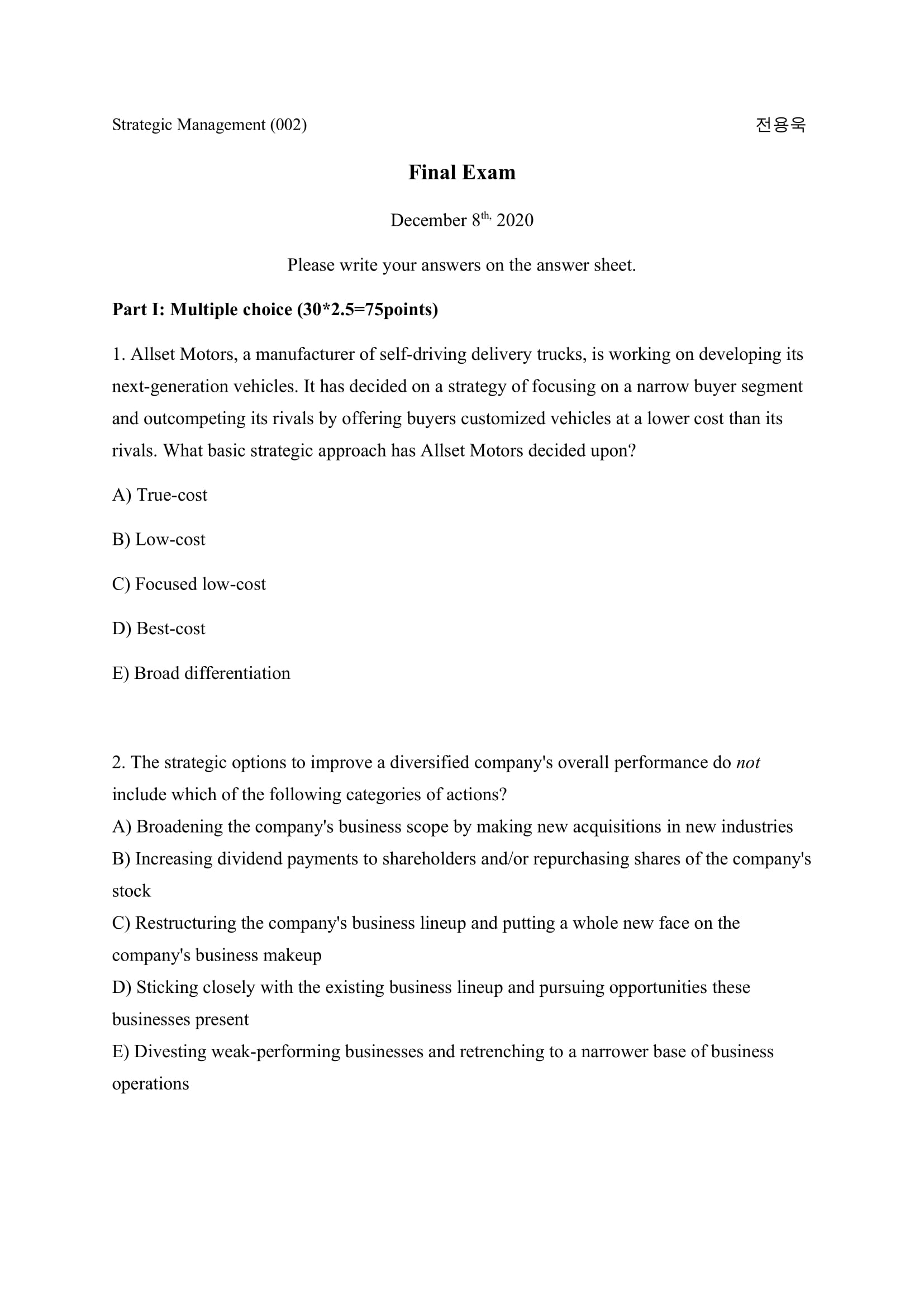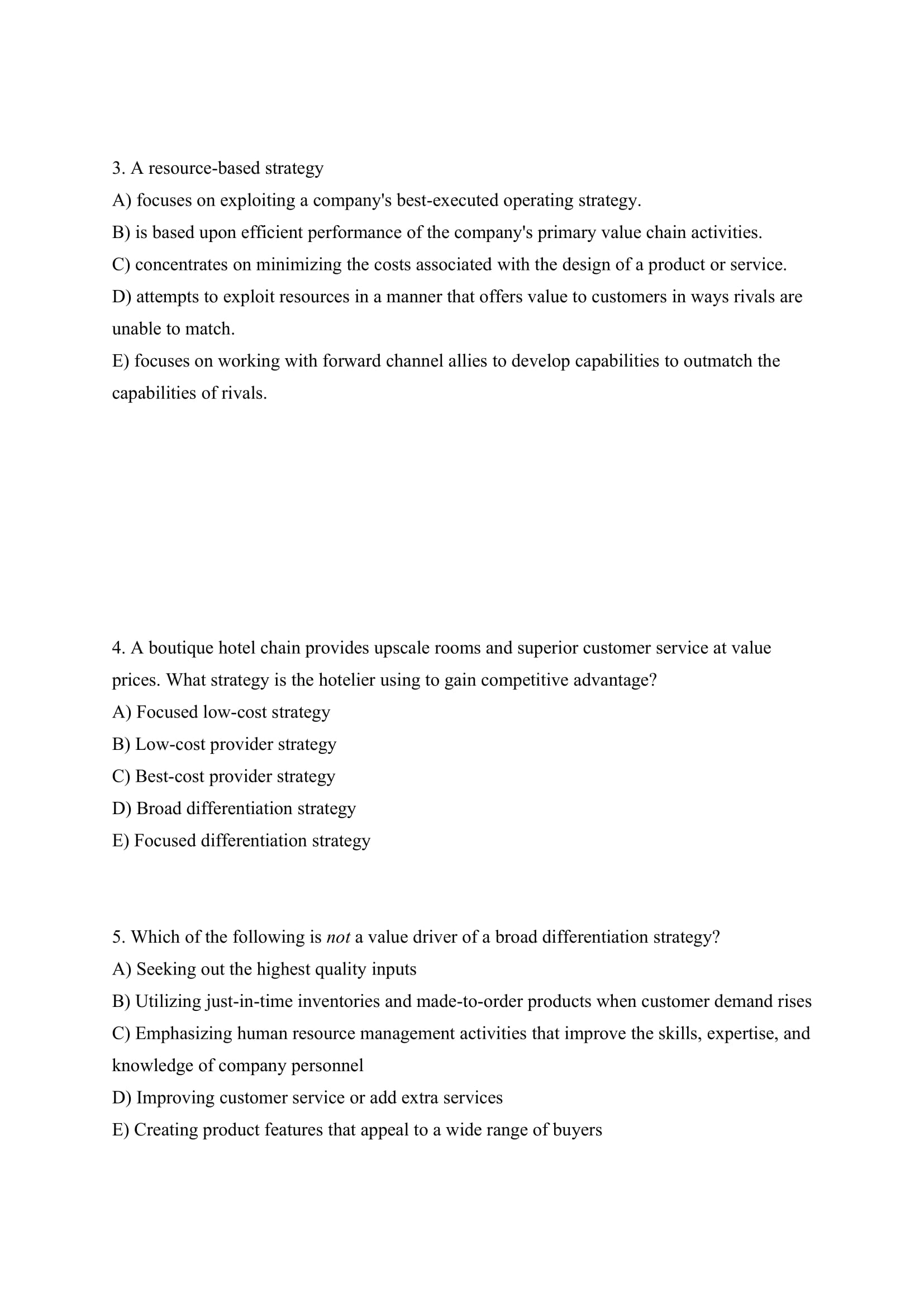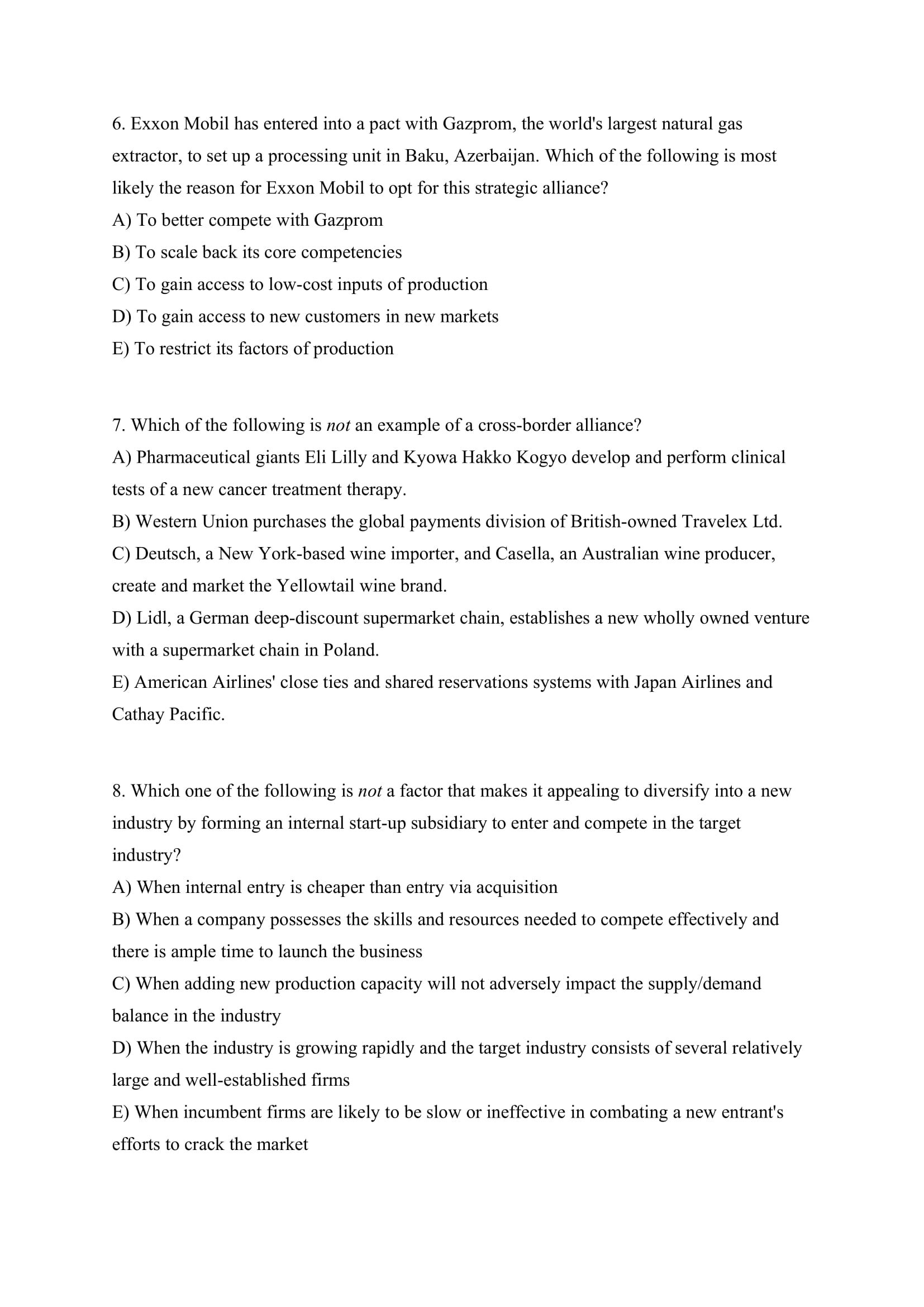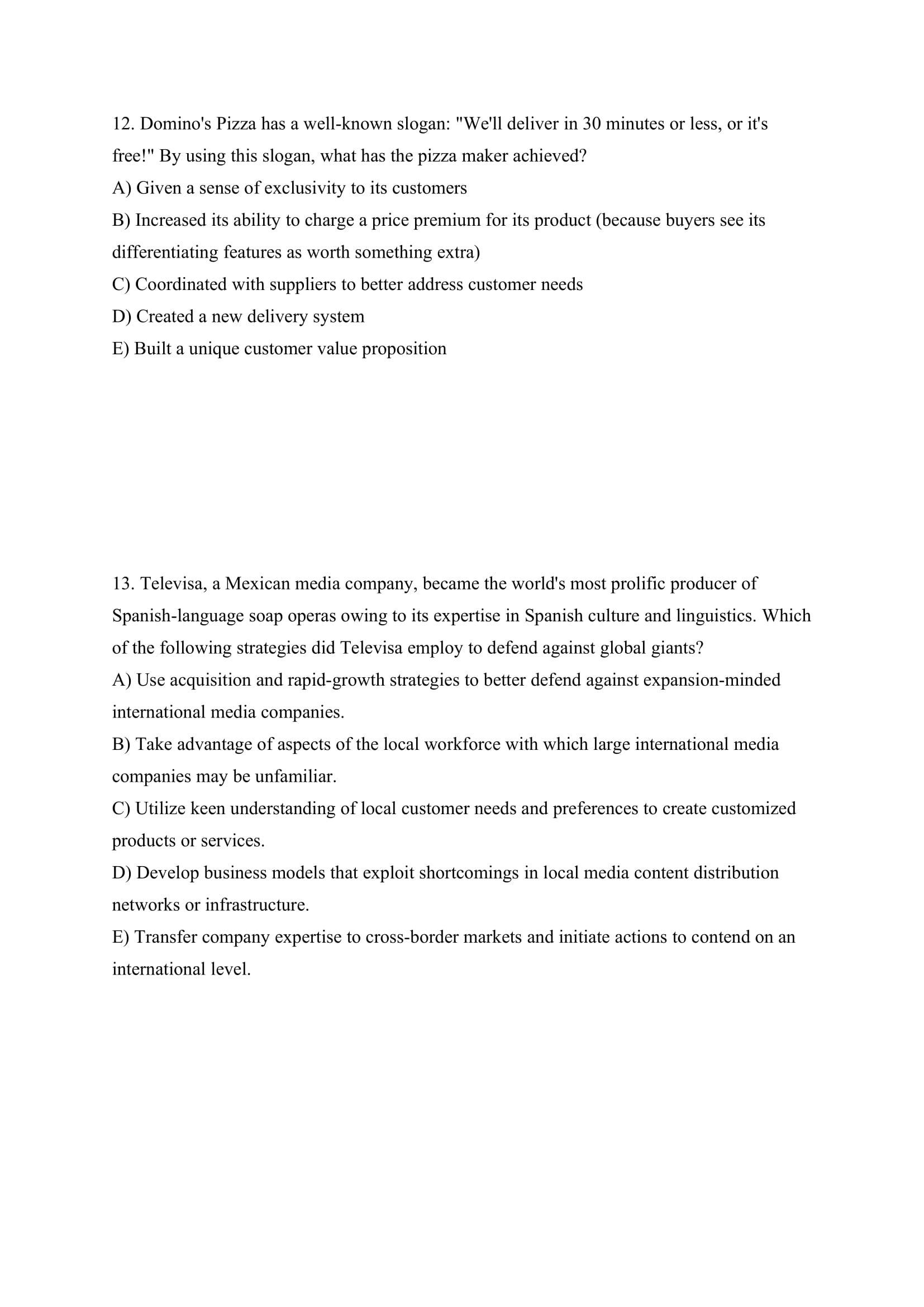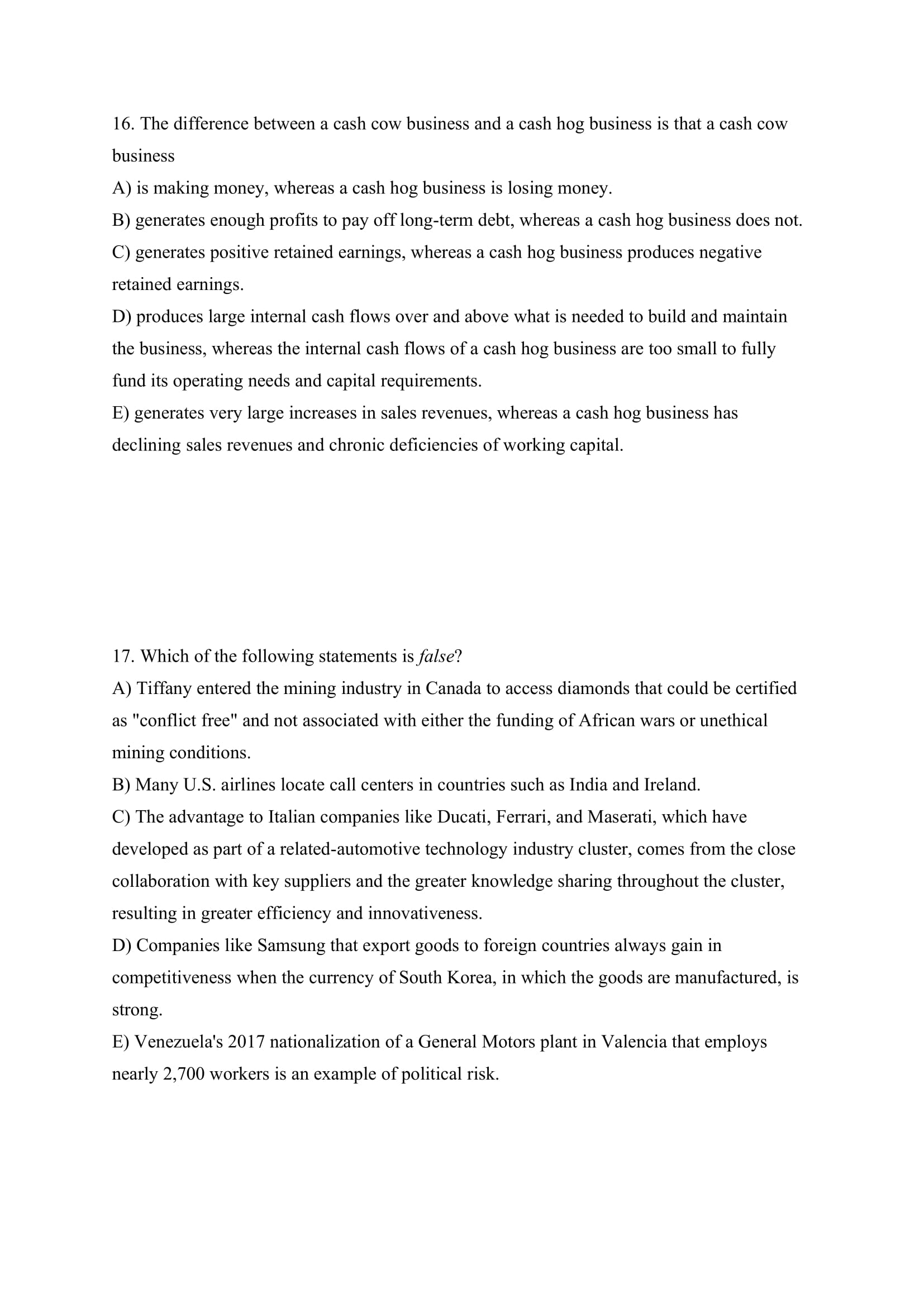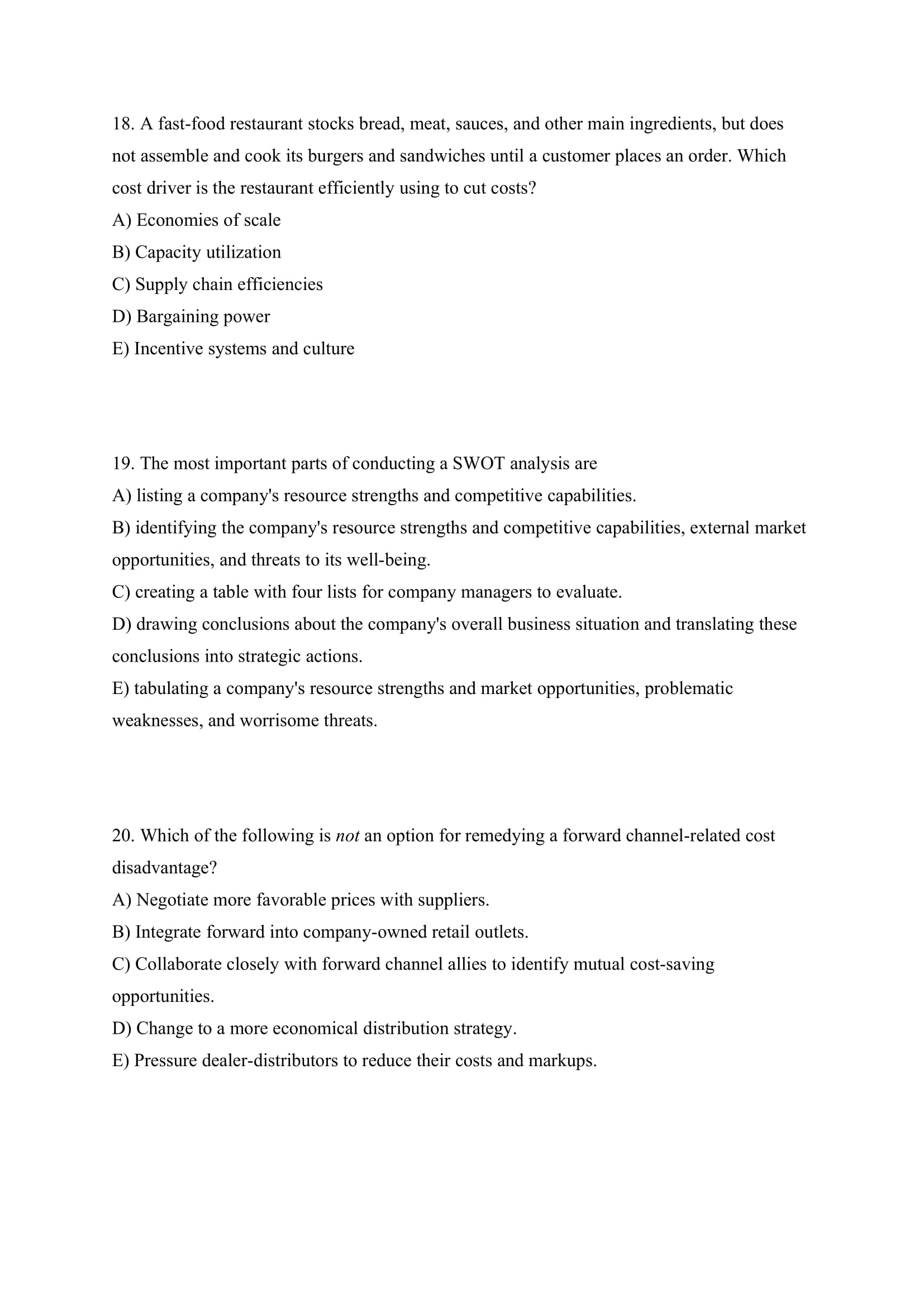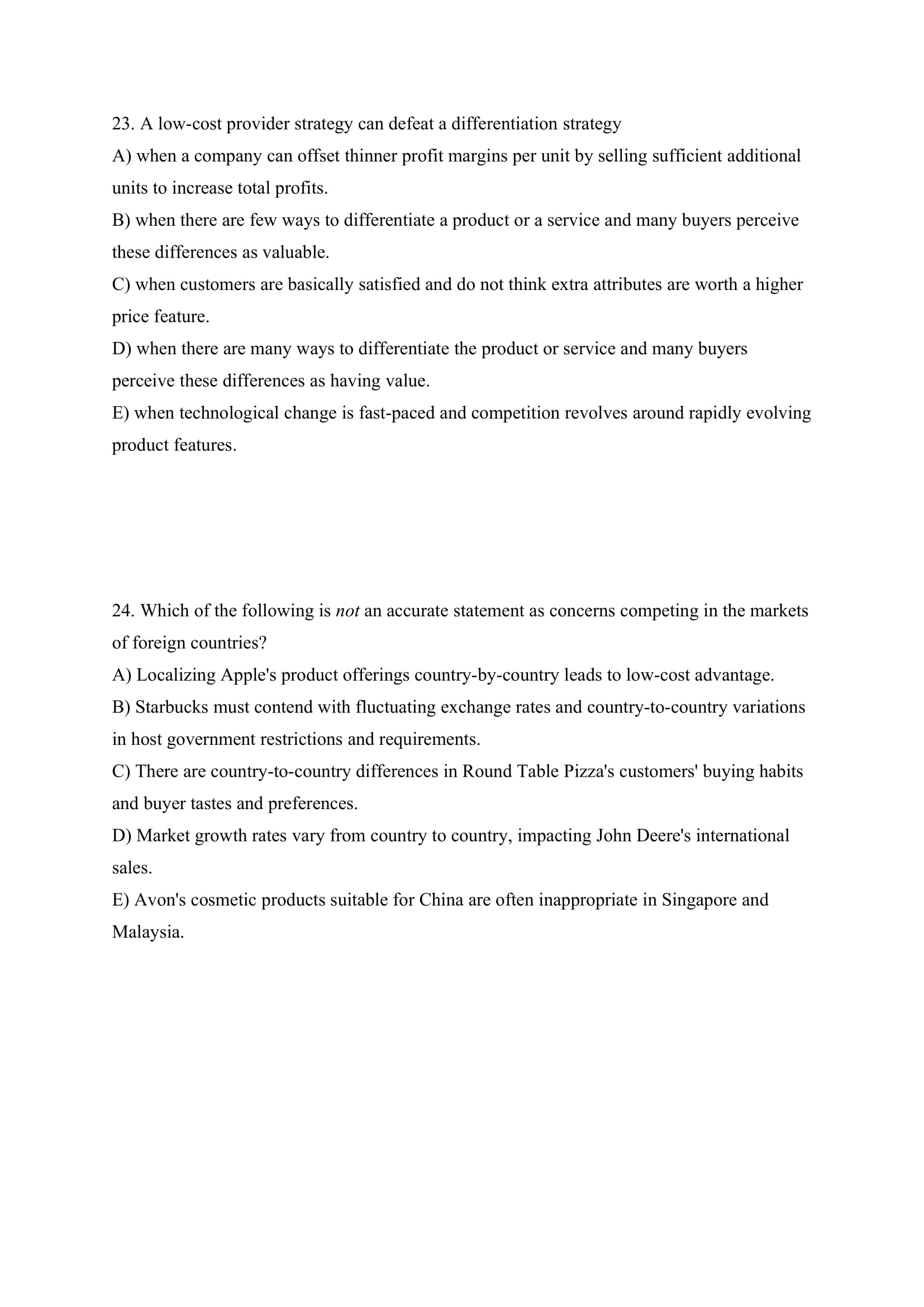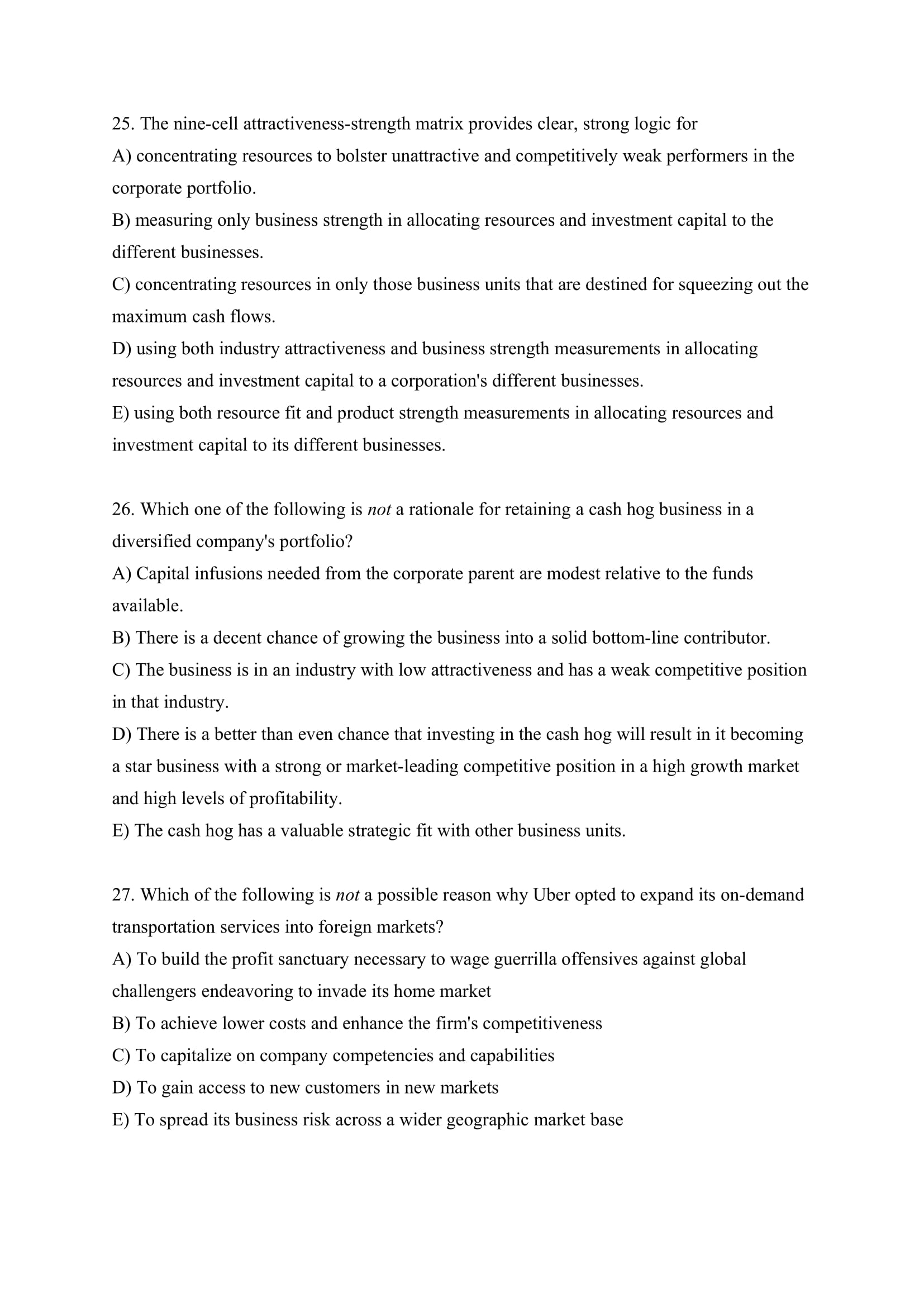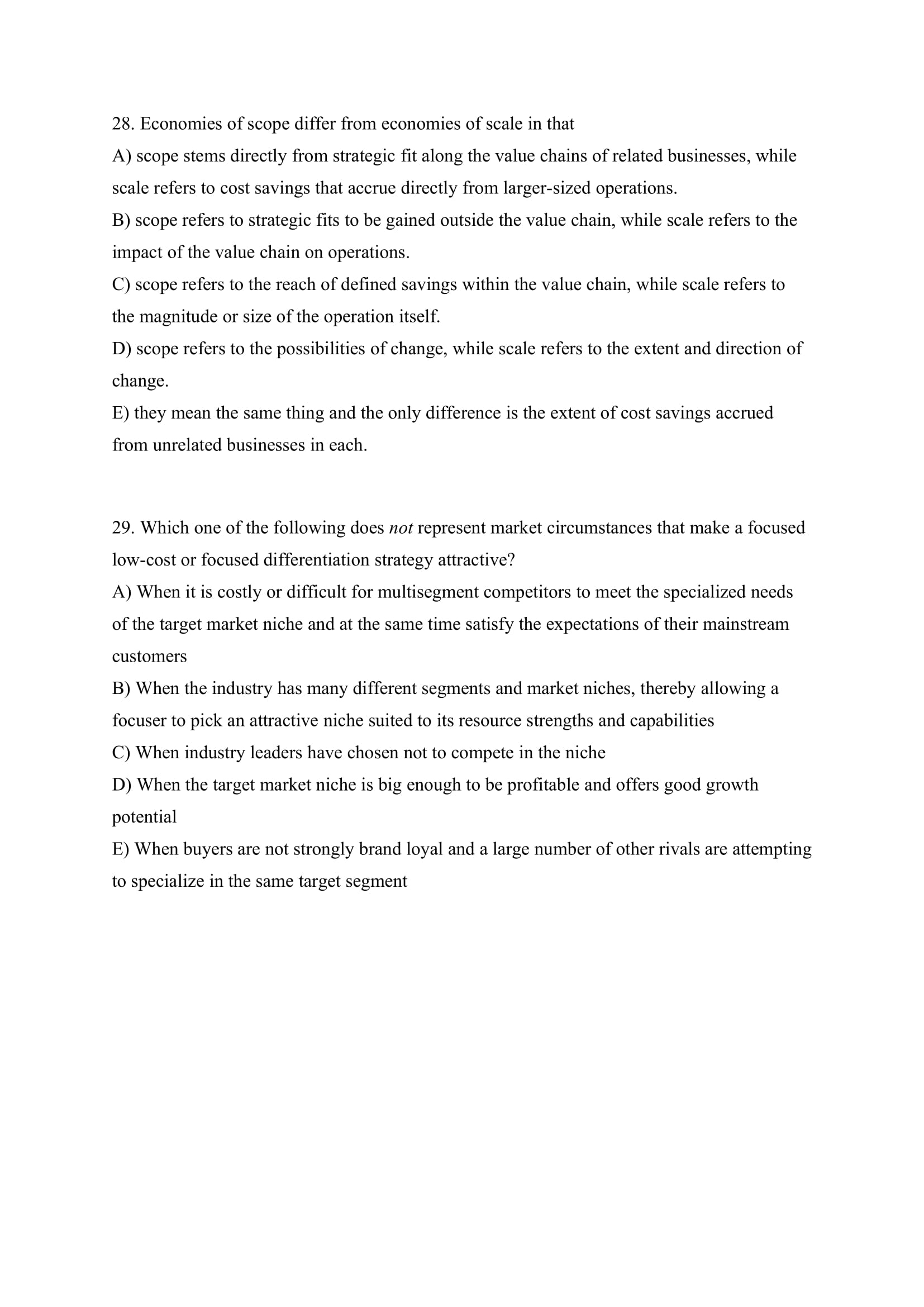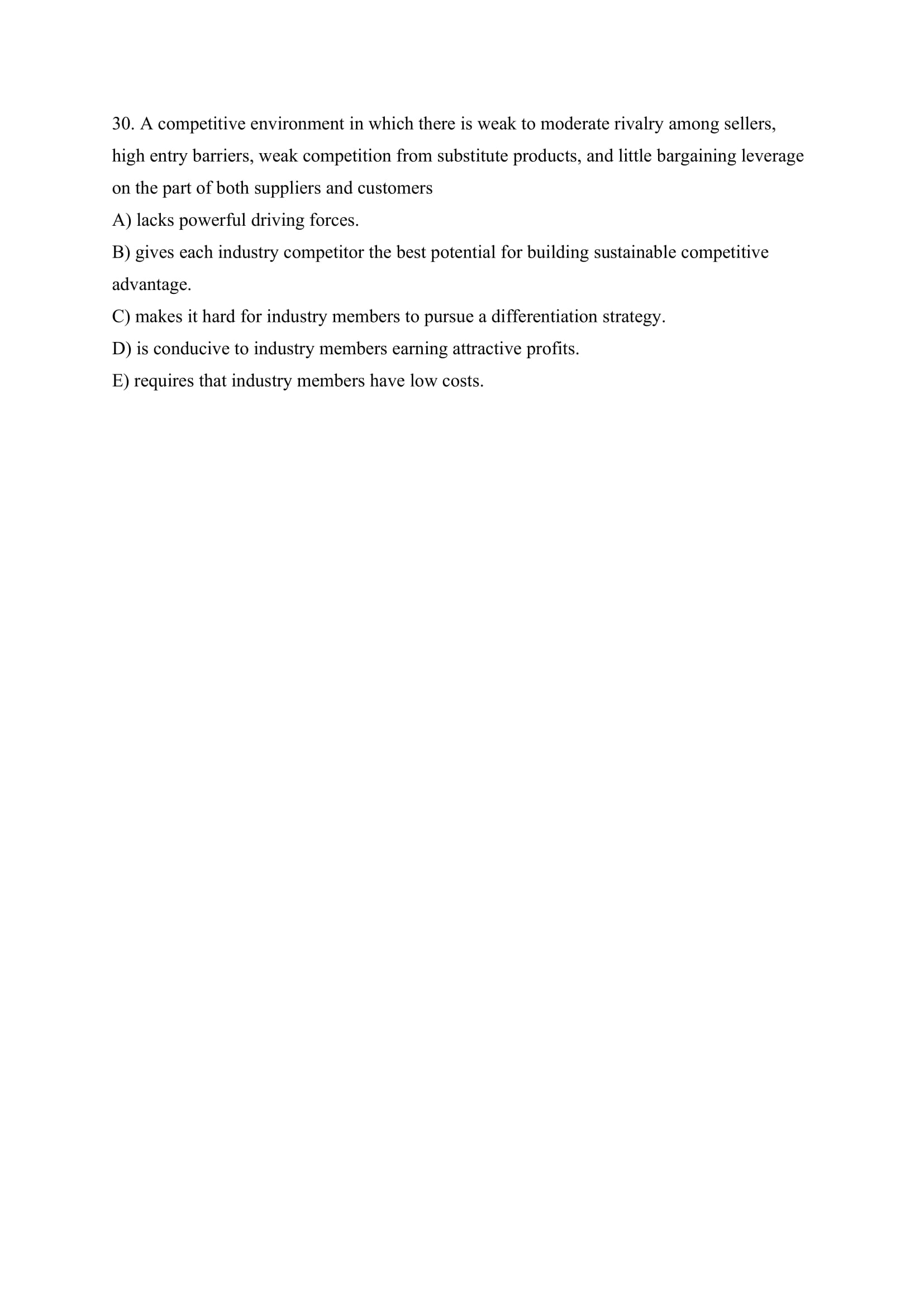answer following MCQ
Strategic Management (002) .73 '39: Final Exam December 8th' 2020 Please write your answers on the answer sheet. Part 1: Multiple choice (30*2.5=75p0ints) 1. Allset Motors, a manufacturer of self-driving delivery trucks, is working on developing its nextgeneration vehicles. It has decided on a strategy of focusing on a narrow buyer segment and outcompeting its rivals by offering buyers customized vehicles at a lower cost than its rivals. What basic strategic approach has Allset Motors decided upon? A) True-cost B) Lowwcost C) Focused lowcost D) Best-cost E) Broad differentiation 2. The strategic options to improve a diversied company's overall performance do not include which of the following categories of actions? A) Broadening the company's business scope by making new acquisitions in new industries B) Increasing dividend payments to shareholders and/or repurchasing shares of the company's stock C) Restructuring the company's business lineup and putting a whole new face on the company's business makeup D) Sticking closely with the existing business lineup and pursuing opportunities these businesses present E) Divesting weak-performing businesses and retrenching to a narrower base of business operations 3. A resource-based strategy A) focuses on exploiting a company's best-executed operating strategy. B) is based upon efcient performance of the company's primary value chain activities. C) concentrates on minimizing the costs associated with the design of a product or service. D) attempts to exploit resources in a manner that offers value to customers in ways rivals are unable to match. E) focuses on working with forward channel allies to develop capabilities to outmatch the capabilities of rivals. 4. A boutique hotel chain provides upscale rooms and superior customer service at value prices. What strategy is the hotelier using to gain competitive advantage? A) Focused lowcost strategy B) Low-cost provider strategy C) Best-cost provider strategy D) Broad differentiation strategy E) Focused differentiation strategy 5. Which of the following is not a value driver of a broad differentiation strategy? A) Seeking out the highest quality inputs B) Utilizing just-intime inventories and made-toorder products when customer demand rises C) Emphasizing human resource management activities that improve the skills, expertise, and knowledge of company personnel D) Improving customer service or add extra services E) Creating product features that appeal to a wide range of buyers 6. Exxon Mobil has entered into a pact with Gazprom, the world's largest natural gas extractor, to set up a processing unit in Baku, Azerbaijan. Which of the following is most likely the reason for Exxon Mobil to opt for this strategic alliance? A) To better compete with Gazprom B) To scale back its core competencies C) To gain access to low-cost inputs of production D) To gain access to new customers in new markets E) To restrict its factors of production 7. Which of the following is not an example of a cross-border alliance? A) Pharmaceutical giants Eli Lilly and Kyowa Hakko Kogyo develop and perform clinical tests of a new cancer treatment therapy. B) Western Union purchases the global payments division of British-owned Travelex Ltd. C) Deutsch, a New York-based wine importer, and Casella, an Australian wine producer, create and market the Yellowtail wine brand. D) Lidl, a German deep-discount supermarket chain, establishes a new wholly owned venture with a supermarket chain in Poland. E) American Airlines' close ties and shared reservations systems with Japan Airlines and Cathay Pacific. 8. Which one of the following is not a factor that makes it appealing to diversify into a new industry by forming an internal start-up subsidiary to enter and compete in the target industry? A) When internal entry is cheaper than entry via acquisition B) When a company possesses the skills and resources needed to compete effectively and there is ample time to launch the business C) When adding new production capacity will not adversely impact the supply/demand balance in the industry D) When the industry is growing rapidly and the target industry consists of several relatively large and well-established firms E) When incumbent firms are likely to be slow or ineffective in combating a new entrant's efforts to crack the market9. Which of the following firms uses an emergent strategy? A) A local hardware store offers a ten-percent discount for seniors on the first Wednesday of every month. B) An online book reseller diversifies into custom book publishing. C) An oil-change franchisor continues geographical expansion despite a recession. D) A health food manufacturer integrates forward into drive-through health food restaurants. E) A microbrewer invests in building community water wells during a drought. 10. Which of the following are integral parts of the managerial process of crafting and executing strategy? A) Deciding on the company's strategic intent, setting financial objectives, crafting a strategy, and choosing what business approaches and operating practices to employ B) Developing a proven business model, deciding on the company's strategic intent, and crafting a strategy C) Setting objectives, crafting a strategy, implementing and executing the chosen strategy, and deciding how much of the company's resources to employ in the pursuit of a sustainable competitive advantage D) Coming up with a statement of the company's mission and purpose, setting objectives, choosing what business approaches to employ, selecting a business model, and monitoring developments E) Developing a strategic vision, setting objectives, crafting a strategy, and initiating corrective adjustments 1 1. Based on an analysis of the five forces that increase or decrease competitive pressures in an industry, in which of the following industries is profitability likely to be lowest? A) Pizza restaurants B) Wireless lighting systems C) Delivery services using drones D) Wearable fitness and health monitors E) Pharmaceuticals12. Domino's Pizza has a wellknown slogan: "We'll deliver in 30 minutes or less, or it's free!" By using this slogan, what has the pizza maker achieved? A) Given a sense of exclusivity to its customers B) Increased its ability to charge a price premium for its product (because buyers see its differentiating features as worth something extra) C) Coordinated with suppliers to better address customer needs D) Created a new delivery system E) Built a unique customer value proposition 13. Televisa, a Mexican media company, became the world's most prolic producer of Spanish-language soap operas owing to its expertise in Spanish culture and linguistics. Which of the following strategies did Televisa employ to defend against global giants? A) Use acquisition and rapid-growth strategies to better defend against expansion-minded international media companies. B) Take advantage of aspects of the local workforce with which large international media companies may be unfamiliar. C) Utilize keen understanding of local customer needs and preferences to create customized products or services. D) Develop business models that exploit shortcomings in local media content distribution networks or infrastructure. E) Transfer company expertise to cross-border markets and initiate actions to contend on an international level. 14. Which of the following does not accurately describe entering a new business via acquisition, internal development, or a joint venture? A) Acquisition is generally the most protable way to enter a new industry, tends to be more suitable for an unrelated diversication strategy than a related diversication strategy, and usually requires less capital than entering an industry via internal startup. B) Acquisition is the most popular means of diversifying into another industry, has the advantage of being quicker than trying to launch a brand-new operation, and offers an effective way to hurdle entry barriers. C) The big dilemma of entering an industry via acquisition of an existing company is whether to pay a premium price for a successil company or to buy a struggling company at a bargain price. D) The big drawbacks to entering a new industry via internal development include the costs of overcoming entry barriers, building an organization from the ground up, and the extra time it takes to build a strong and protable competitive position. E) Joint ventures are an attractive way to enter new businesses when the opportunity is too complex, uneconomical, or risky for one company to pursue alone, when the opportunities in a new industry require a broader range of competencies and know~how than a company can marshal on its own, and/or when it aids entry into a foreign market, 15 . Which one of the following is not a reasonable option for deploying a diversied company's nancial resources? A) Making acquisitions to establish positions in new businesses or to complement existing businesses B) Concentrating most of a company's nancial resources in cash cow businesses and allocating little or no additional resources to cash hog businesses until they show enough strength to generate positive cash ows C) Funding long~range R&D ventures aimed at opening market opportunities in new or existing businesses D) Paying down existing debt, increasing dividends, or repurchasing shares of the company's stock E) Investing in ways to strengthen or grow existing businesses 16. The difference between a cash cow business and a cash hog business is that a cash cow business A) is making money, whereas a cash hog business is losing money. B) generates enough profits to pay off long-term debt, whereas a cash hog business does not. C) generates positive retained earnings, whereas a cash hog business produces negative retained earnings. D) produces large internal cash flows over and above what is needed to build and maintain the business, whereas the internal cash flows of a cash hog business are too small to fully fund its operating needs and capital requirements. E) generates very large increases in sales revenues, whereas a cash hog business has declining sales revenues and chronic deficiencies of working capital. 17. Which of the following statements is false? A) Tiffany entered the mining industry in Canada to access diamonds that could be certified as "conflict free" and not associated with either the funding of African wars or unethical mining conditions. B) Many U.S. airlines locate call centers in countries such as India and Ireland. C) The advantage to Italian companies like Ducati, Ferrari, and Maserati, which have developed as part of a related-automotive technology industry cluster, comes from the close collaboration with key suppliers and the greater knowledge sharing throughout the cluster, resulting in greater efficiency and innovativeness. D) Companies like Samsung that export goods to foreign countries always gain in competitiveness when the currency of South Korea, in which the goods are manufactured, is strong. E) Venezuela's 2017 nationalization of a General Motors plant in Valencia that employs nearly 2,700 workers is an example of political risk.18. A fastfood restaurant stocks bread, meat, sauces, and other main ingredients, but does not assemble and cook its burgers and sandwiches until a customer places an order. Which cost driver is the restaurant efciently using to cut costs? A) Economies of scale B) Capacity utilization C) Supply chain efciencies D) Bargaining power E) Incentive systems and culture 19. The most important parts of conducting a SWOT analysis are A) listing a company's resource strengths and competitive capabilities. B) identifying the company's resource strengths and competitive capabilities, external market opportunities, and threats to its well-being. C) creating a table with four lists for company managers to evaluate. D) drawing conclusions about the company's overall business situation and translating these conclusions into strategic actions. E) tabulating a company's resource strengths and market opportunities, problematic weaknesses, and worrisome threats. 20. Which of the following is not an option for remedying a forward channelrelated cost disadvantage? A) Negotiate more favorable prices with suppliers. B) Integrate forward into company-owned retail outlets. C) Collaborate closely with forward channel allies to identify mutual cost~saving opportunities. D) Change to a more economical distribution strategy. E) Pressure dealer-distributors to reduce their costs and markups. 21. The obligations of an investorowned company's board of directors in the strategy making, strategy-executing process include A) debating the merits of other compelling strategy proposals as opposed to those put forward by top management. B) taking the lead in formulating the company's strategic plan but then delegating the task of implementing and executing the strategic plan to the company's CEO and other senior executives. C) taking the lead in developing the company's business model and strategic vision. D) overseeing the company's nancial accounting and nancial reporting practices and evaluating the caliber of senior executives' strategy-making, strategy-executing skills. E) approving the company's operating strategies, functionalarea strategies, business strategy, and overall corporate strategy. 22. Which of the following do not qualify as potential driving forces capable of inducing mdamental changes in industry and competitive conditions? A) Changes in who buys the product and how they use it, changes in the long-term industry growth rate, and changes in cost and efciency B) Entry or exit of major rms, product innovation, and marketing innovation C) Increases in the economic power and bargaining leverage of customers and suppliers, growing supplier-seller collaboration, and growing buyer-seller collaboration D) Diffusion of technical knowhow and changing societal concerns, attitudes, and lifestyles E) Changes in manufacturing processes brought on by technological change, increasing globalization of the industry, and new Internet capabilities 23. A low-cost provider strategy can defeat a differentiation strategy A) when a company can offset thinner prot margins per unit by selling sufcient additional units to increase total prots. B) when there are few ways to differentiate a product or a service and many buyers perceive these differences as valuable. C) when customers are basically satised and do not think extra attributes are worth a higher price feature. D) when there are many ways to differentiate the product or service and many buyers perceive these differences as having value. E) when technological change is fast-paced and competition revolves around rapidly evolving product features. 24. Which of the following is not an accurate statement as concerns competing in the markets of foreign countries? A) Localizing Apple's product offerings country-by-country leads to low-cost advantage. B) Starbucks must contend with uctuating exchange rates and country~to~country variations in host government restrictions and requirements. C) There are country~to~country differences in Round Table Pizza's customers' buying habits and buyer tastes and preferences. D) Market growth rates vary from country to country, impacting John Deere's international sales. E) Avon's cosmetic products suitable for China are often inappropriate in Singapore and Malaysia. 25. The ninecell attractiveness~strength matrix provides clear, strong logic for A) concentrating resources to bolster unattractive and competitively weak performers in the corporate portfolio. B) measuring only business strength in allocating resources and investment capital to the different businesses. C) concentrating resources in only those business units that are destined for squeezing out the maximum cash ows. D) using both industry attractiveness and business strength measurements in allocating resources and investment capital to a corporation's different businesses. E) using both resource t and product strength measurements in allocating resources and investment capital to its different businesses. 26. Which one of the following is not a rationale for retaining a cash hog business in a diversied company's portfolio? A) Capital infusions needed from the corporate parent are modest relative to the funds available. B) There is a decent chance of growing the business into a solid bottomline contributor. C) The business is in an industry with low attractiveness and has a weak competitive position in that industry. D) There is a better than even chance that investing in the cash hog will result in it becoming a star business with a strong or market~leading competitive position in a high growth market and high levels of protability. E) The cash hog has a valuable strategic fit with other business units. 27. Which of the following is not a possible reason why Uber opted to expand its ondemand transportation services into foreign markets? A) To build the profit sanctuary necessary to wage guerrilla offensives against global challengers endeavoring to invade its home market B) To achieve lower costs and enhance the rm's competitiveness C) To capitalize on company competencies and capabilities D) To gain access to new customers in new markets E) To spread its business risk across a wider geographic market base 28. Economics of scope differ from economies of scale in that A) scope stems directly from strategic t along the value chains of related businesses, while scale refers to cost savings that accrue directly from largersized operations. B) scope refers to strategic ts to be gained outside the value chain, while scale refers to the impact of the value chain on operations. C) scope refers to the reach of dened savings within the value chain, while scale refers to the magnitude or size of the operation itself. D) scope refers to the possibilities of change, while scale refers to the extent and direction of change. E) they mean the same thing and the only difference is the extent of cost savings accrued from unrelated businesses in each. 29. Which one of the following does not represent market circumstances that make a focused low-cost or focused differentiation strategy attractive? A) When it is costly or difcult for multisegment competitors to meet the specialized needs of the target market niche and at the same time satisfy the expectations of their mainstream customers B) When the industry has many different segments and market niches, thereby allowing a focuser to pick an attractive niche suited to its resource strengths and capabilities C) When industry leaders have chosen not to compete in the niche D) When the target market niche is big enough to be protable and offers good growth potential B) When buyers are not strongly brand loyal and a large number of other rivals are attempting to specialize in the same target segment 30. A competitive environment in which there is weak to moderate rivalry among sellers, high entry barriers, weak competition from substitute products, and little bargaining leverage on the part of both suppliers and customers A) lacks powerful driving forces. B) gives each industry competitor the best potential for building sustainable competitive advantage. C) makes it hard for industry members to pursue a differentiation strategy. D) is conducive to industry members earning attractive prots. E) requires that industry members have low costs
